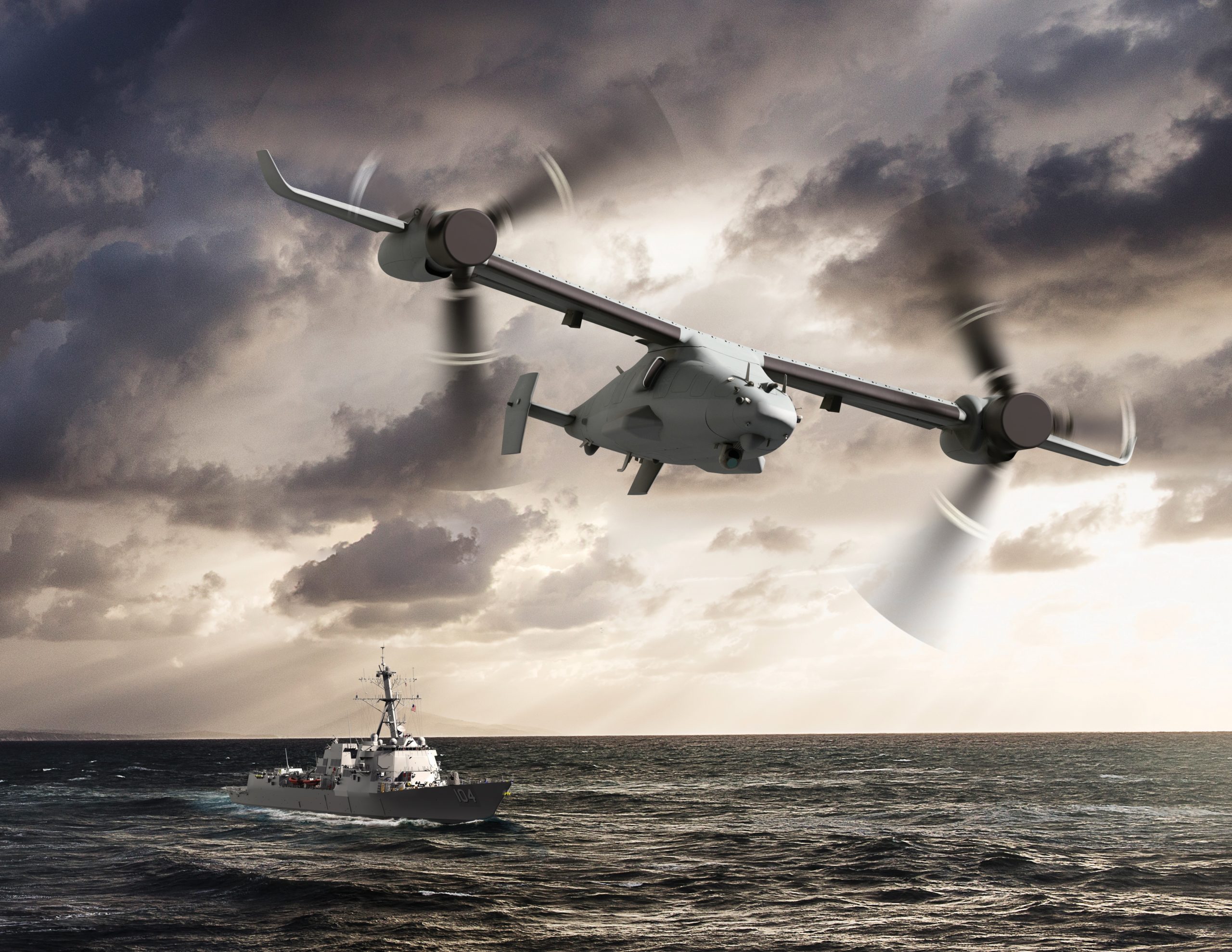Preparing the Navy for the IndoPacific: Advancing UAS for Great Power Competition
After twenty years supporting the Global War on Terrorism, the U.S. Navy finds itself having to rapidly retool its arsenal for a very different set of threats and missions. Combating terrorism is a very different mission than facing a peer competitor in the IndoPacific. This shift will challenge every community in the Navy, but perhaps none more than the surface fleet.
During any conflict against a peer or near peer adversary, US Navy surface combatants will need to find, fix, and destroy surface and submarine targets at ranges beyond those supported by current embarked unmanned aircraft systems (UASs) and helicopters. Any future system must significantly reduce the logistical support needed to support and sustain operations. It must combine the vertical lift capability of a helicopter with the speed and range of a conventional fixed-wing aircraft, provide 24-hour persistent surveillance, and be able to deliver long-range precision fires.
Surface Action Groups (SAGs) face significant capability gaps in organic Intelligence, Surveillance, Reconnaissance, and Targeting (ISR-T). While manned aircraft, such as the Maritime Patrol and Reconnaissance (MPRA) P-8 Poseidon, conduct a significant part of this mission, unmanned aircraft systems (UAS) are by-and-large more suitable. And while the MQ-4C Triton is an outstanding ISR-T platform, offering the long range and endurance of a UAS, it shares some of the same liabilities as the P-8—it needs a long runway and infrastructure ashore.
The Navy lags in fielding shipboard-capable UAS to perform this mission. The MQ-8C, ScanEagle, and RQ-21A all have limited range, significantly less than 150 nm. This means that the ship’s own weapons will usually outrange the visibility afforded by its UAS support. You can only hit what you can observe. The limited range and endurance of current naval UAS means that the use of highly capable weapons, such as the Tomahawk Block V, is greatly constrained. As a result, surface combatants are left dependent on higher-echelon assets to acquire and track targets.
Similarly, those combatants rely on Maritime Patrol and national assets to alert them of potential threats. Peer and near-peer adversaries have systems like the YJ-12B cruise missile that can be launched from well outside the range of current Navy tactical UASs. By the time the ship’s organic sensors detect the inbound threat, the time-to-impact is short, and the point of origin has moved.

This puts a significant burden on a finite quantity of MPRA and other shore-based assets, which are further limited by their runway and infrastructure requirements. Supporting a fleet conducting Distributed Maritime Operations (DMO) will severely stress even well-resourced land-based air support. Even if there are sufficient assets, they may not be near the point of need in terms of either responsiveness to emergent threats or in time-on-station once they arrive. They are further constrained by the competing priorities of higher—and in the event of a peer or near-peer conflict, there will be a lot of competition.
And that’s just in terms of providing targeting information and situational awareness. No current Navy UAS, even the MQ-4C, has the capability to launch its own ordnance. This means that the only airborne striking power available to any surface combatant is the venerable MH-60R. While a capable platform, the MH-60R is limited in range, altitude, and endurance by its inherent nature as a manned helicopter. That’s not even accounting for the risk in exposing human aircrew to a medium or high-threat environment with limited ability to conduct personnel recovery.
Surface combatants, especially DDGs, will provide the preponderance of the Navy’s tactical striking power in the event of a major conflict, yet they are not being provided UAS commensurate with their value to the fleet. The Navy needs to replace the Seahawk aboard DDGs with an unmanned system capable of carrying a comparable sensor and weapon loadout, to include torpedoes and long-range missiles, but at significantly greater ranges.
The physics of carrying larger sensors and weapons at long range and endurance are unchanging. There is a steep change in capability with larger UASs. While small UASs are often rapidly developed and iterable, larger UASs are major weapons systems. They need concerted and sustained programmatic effort to develop and field. The threat is not diminishing. Technologies exist that can put an MPRA-type capability on the back of destroyers – “Group 5” large UAS with Vertical Takeoff and Landing (VTOL) capability.
One example of that technology is the Bell V-247 Vigilant. The V-247 represents a next-generation unmanned capability based on proven tiltrotor technology and performance, which are also foundations of the V-280 Valor manned tiltrotor recently chosen as the basis for the Army’s Future Long Range Assault Aircraft (FLRAA). The jump in capability from current aircraft is not limited to advances in rotors and drive systems, but also in the Modular Open Systems Approach (MOSA) underneath the skin. MOSA will allow the V-247 to deploy the newest sensors and weapons throughout its service life.
Regardless of the aircraft chosen, the Navy needs to set its course now. While smaller UAS will fill near-term capability gaps, without the right vision and resources today, the surface Navy will face the threats of 2035 with a UAS capability not much changed from the Navy of 2025. The Navy’s UAS roadmap needs to incorporate not just the exigent requirements of today’s operational environment, but those of the 2030s and beyond.
Carl Forsling and Chris Misner are Senior Managers for Military Sales & Strategy at Bell.
Featured Phhoto: The V-247 Vigilant is an example of a modern unmanned system designed to meet the challenges posed by future conflicts. Image by Bell, Textron. Inc

